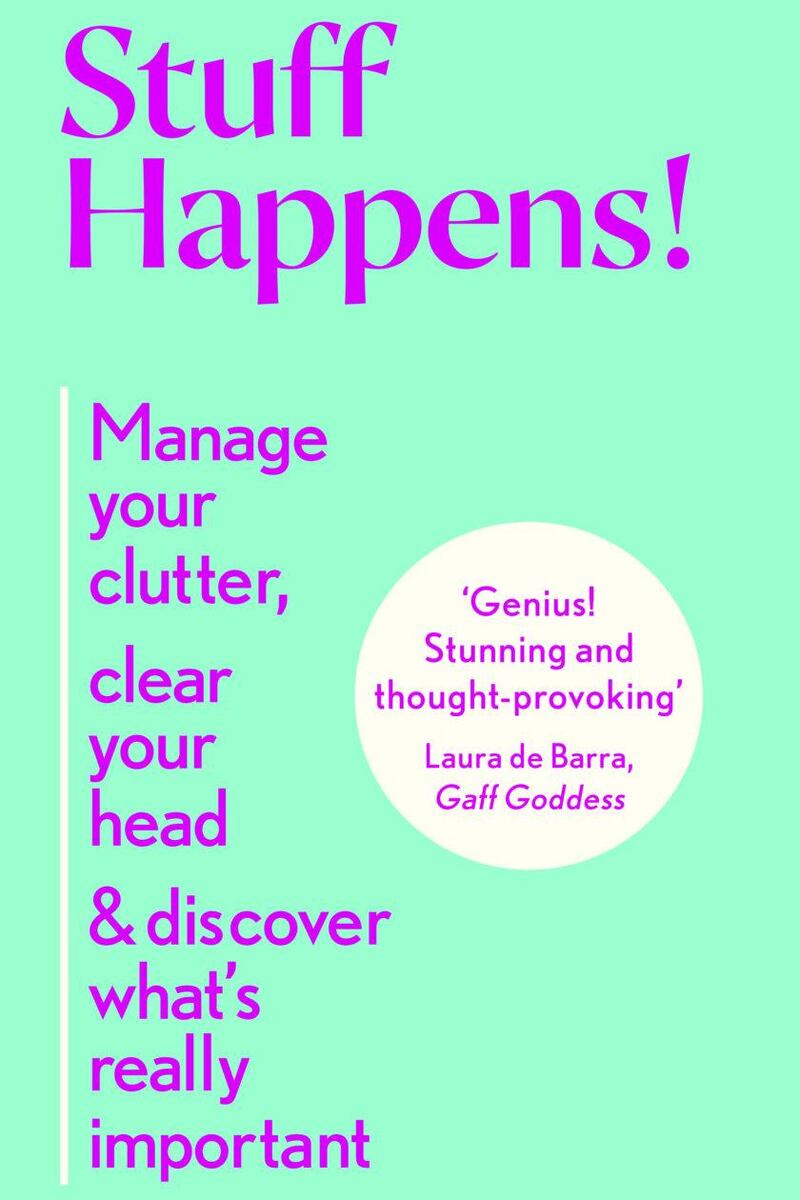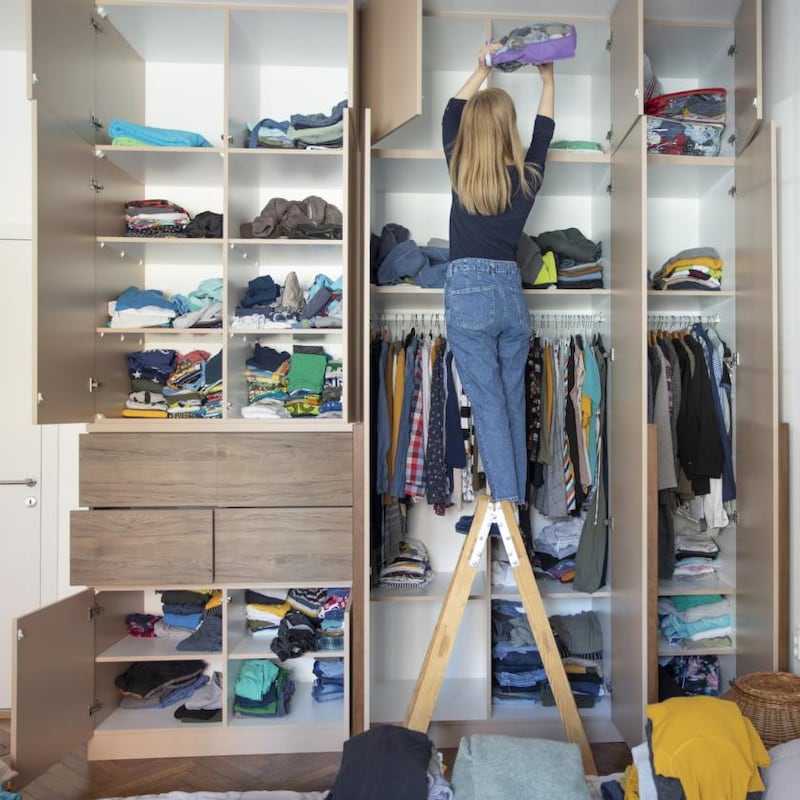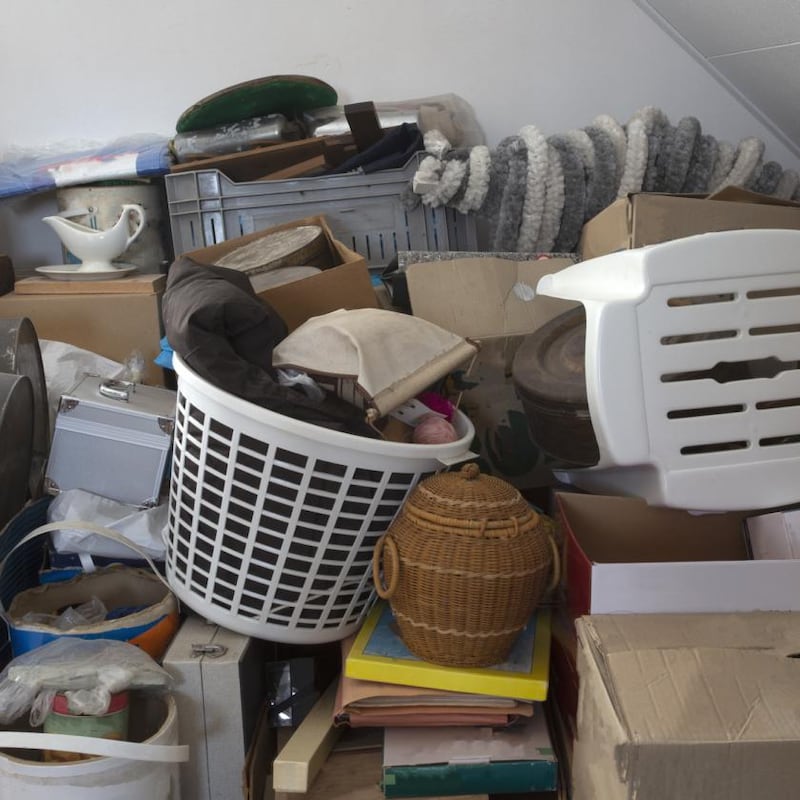If you want to see a pocket of the publishing industry that has quite literally cleaned up in the past five years, look no further than the decluttering manual.
Spearheaded by Marie Kondo, an army of organisers, declutterers and life-sorters have sold millions (and millions) of books which purport to unleash the minimalist within. Yet for all the practical guides on how to strategise clearouts and win against the battle of stuff, few manuals truly get to the root of the matter.
Enter no-nonsense Dubliner Emma Gleeson’s guide, Stuff Happens!. Like many of her peers, Gleeson, founder of the sustainable decluttering business Give Up Yer Auld Tings, offers plenty of practical advice on how to get an over-abundance of A, or a needless surplus of B, out of your house. But unlike many of her peers, she is also keen to get to the root, often ugly as it is, of just why we have so much stuff.
“It’s about addressing the elephant in the room; talking about how all this stuff gets into the house in the first place,” she notes. “I read a lot of books similar to this as research, and so many of them were exactly the same, but if you don’t address why you’re doing it, it’s like going on a crash diet – it won’t stick and you’ll be back to square one within months. We really need to step back and look at why this is happening.”

In her 20s, Gleeson moved to the UK to study at the London College of Fashion. She has worked as a costume designer, events co-ordinator, sustainable fashion lecturer and is a published poet. Venturing into the world of sustainability offered her a wake-up call, not just about her own collecting tendencies but about mindless shopping.
It arrives into your life and you have a bit of a glow from the dopamine hit, then we adapt to these 'new circumstances'
“A friend of mine did a master’s on the psychology of the young female consumer and it’s basically, ‘I deserve to buy loads of new things’, or ‘look, I’ve cleared out my wardrobe, so I can [spend] again’,” Gleeson explains.
“In the last hundred years, objects have become connected to emotions, rather than valued on their usefulness. You might buy something not because it’s useful, but because it might build part of your identity. And in this time of individualism, we’ve also been taught that buying something new will make you feel better. The thing is, it’s been proven that your peak happiness around buying an item actually happens in the moments before you pay for it. It arrives into your life and you have a bit of a glow from the dopamine hit, then we adapt to these ‘new circumstances’. It goes into your wardrobe and fades into the background of your life.”
In the pandemic, it’s been easier than ever to fall into this cycle, not least because as humans, we crave novelty and excitement, and opportunities to access this are often limited to experiences such as shopping.
Gleeson is not here, incidentally, to put a dampener on the simple joy of buying something lovely. She will not be advising, as Kondo may or may not have done, to have one black jumper instead of 12, or limit one’s library to 30 books.
“This advice isn’t about denying yourself anything,” she declares. “It’s about being more mindful in your shopping. It’s about enhancing your enjoyment around it. Sustainability has been framed within the language of deprivation for so long; what I’m saying is, ‘I’m trying to make you enjoy your life more’.”
One of the first beliefs that Gleeson is keen to debunk is the charity shop as a panacea for a cluttered space.
“Yes, it’s wonderful to donate to charity, and certainly better to donate to charity than sending things to landfill, but the charity shops simply becomes a dumping ground for our endless cycle of buying sh*t,” Gleeson warns.

Things on this front have become even more complicated because pandemic restrictions mean charity shops aren’t even open. On which Gleeson says: “Liberty [clothing] recycling banks are great, while you could also try putting stuff on Adverts.ie. You’d be amazed how much free stuff is put on there. It’s also worth contacting direct provision centres or homeless charities in your area. Charity shops are always so overwhelmed that I always try to pass stuff directly to people who might need it.”
To engender a psychological sense of “retail novelty”, Gleeson makes an intriguing suggestion.
“My favourite tip is to rotate your wardrobe,” she says. “Put away some clothes that you love . . . and when you have that niggle [to shop], go into that bag and it’s like you’ve gone shopping. You get that hit of something ‘fresh’.”
...Our wellness culture and obsession with thinness compels many women to hang on to the smallest garments...
Stuff Happens! is replete with practical advice too, from how to get rid of a junk drawer to tackling the attic (“Put it in the attic is not a decision,” she says) and what to do with things such as gifts or sentimental items. Plenty of relatable habits are pinpointed, from holding on to items like expensive candles “for good” to stockpiling “because then we’ll have it”.
Getting these small but niggly jobs done “makes such a difference”, notes Gleeson. “You’re not in a constant battle in your home. When you need the Sellotape, you know where it is. Your quality of life goes up.”
Gleeson also writes extensively about wardrobes, women and body image: most women have a wardrobe that spans several dress sizes, even though they are not likely to wear the smaller sizes ever again. Still, our wellness culture and obsession with thinness compels many women to hang on to the smallest garments, just in case.
“I’ve never had a client who doesn’t have that,” Gleeson reveals. “But if you get to the root of it, you can free yourself from it. I promise you can. It’s about sitting with any discomfort around your body. Has your body changed forever? Is it a temporary thing, like after childbirth? I cannot emphasise enough how fantastic it is to take those ideas to the core of your mind. The freedom of giving up the idea that ‘some day I’ll be thin’ . . . well, it’s a joy. My own weight fluctuates a lot, but it doesn’t bother me anymore.”
As a youngster, Gleeson enjoyed organising her possessions, and was a “bit of a clutterbug”. As a former costume designer for film and theatre she amassed vintage fabrics and accessories before moving into decluttering – for friends, initially – until she realised, “God, I’m quite good at this”.
“I’ve gone from the woman living in clutter, hanging on to make-up samples and clothes that didn’t fit me,” she says. “Books are my total Kryptonite. But I have lived and gone through that process.”
Gleeson soon realised that for many people overwhelmed by the prospect of decluttering, employing an impartial party was a big help.

“People can get so stuck that having a skilled and empathetic stranger there telling them what to do is actually very useful,” she notes.
She says sometimes “you feel you need a counselling qualification” doing her job.
“People are really going through some stuff a lot of the time. You need a while to recover from each person’s story.”
'This stuff can get a bit overwhelming and if you're too upset about the process to engage in it, forget it'
Is there a common reason for decluttering, or do her clients react in much the same way when asked to part with some of their material possessions?
“Yes, the things people feel guilty about,” she says. “Money spent on things that aren’t used, and inherited items that are unwanted. The reasons behind the guilt are likely universal.”
Getting started on the practicalities of a decluttering project should always mean starting small, says Gleeson.
“Make a list of what’s bothering you in your house, and whatever is bothering you most, don’t start with that,” she says. “Do something that will stress you out less, like a single drawer or a bedside locker. Relish the sense of achievement that will spur you on.
“This stuff can get a bit overwhelming and if you’re too upset about the process to engage in it, forget it,” she continues. “I had one client going through a messy divorce and she simply wasn’t in the headspace for a clearout, and she was furious with me. It was a big lesson; you have to prepare yourself and be calm. You’ll be way more tired doing this than you realise. My sessions are four hours’ long, and that’s usually enough. You’ll be whacked out even after that. Have a cry, or even a sip of whiskey , if you need to.”
Stuff Happens! Manage Your Clutter, Clear Your Head and Discover What’s Really Important by Emma Gleeson is published by Penguin/Sandycove

The ‘organise your home’ rules you never knew you needed
– Have a designated area for items without a purpose such as electrical leads you don’t know the use for, Tupperware with no lid, or solo shoes. Place these in a box with a label stating the date of their storage. If, the next time you discover the box, they are all still unused, out they go.
– If items need to be fixed, place them in an easily reachable area near the front door and schedule a time to make the repair happen.
– Doing a book clearout? Titles which can definitely go include: out-of-date manuals and textbooks; bestselling novels or Man Booker winners from the early 2000s that you bought and never read, and know you’ll never read but keep out of some sort of intellectual guilt; out-of-date exercise and diet books.
– We have internalised a narrative around clothing that if an item doesn’t fit or suit, your body is wrong for the clothes. Practise repeating that it’s the clothes that are wrong for your body, not the other way around.
– Divide your drawers. You don’t need fancy storage solutions. Settle for using whatever boxes you have to hand. Roll your tights up and keep them in a cardboard box; one for black, one for navy and one for anything else.

















